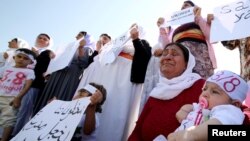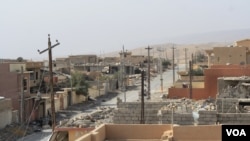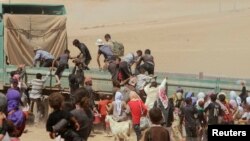Iraqi Yazidis have prepared a master plan to construct a new town next to their former homes in Sinjar, a town in northern Iraq destroyed by the Islamic State (IS) militants who killed thousands of Yazidis, Sinjar’s mayor told VOA.
While the rubble of the old town will serve as a symbol of the atrocities committed by IS, the new town will provide places for thousands of displaced Yazidis, Sinjar Mayor Mahma Khalil said.
“People of Sinjar have very painful memories about the IS massacre in this town and they don’t want to return,” Khalil said. “We’re working on a new Sinjar that will be built according to standards of modern cities.”
Ancestral home
Sinjar was once an ancestral home for more than 200,000 people of the religious minority in northern Iraq.
IS militants took over the town in early August 2014 and murdered roughly 5,000 of its male residents and enslaved thousands of women and children. Those who managed to escape became trapped on Sinjar Mountain, leading to an international response, including U.S. airstrikes.
When the U.S.-backed Kurdish army, called the peshmerga, liberated the town in 2015, it was in ruins. Yazidi officials and organizations estimate that more than 80 percent of the city’s buildings and infrastructure have been destroyed.
“Out of 10,137 buildings, more than 5,700 buildings are razed to the ground and 3,400 buildings are 70 percent destroyed,” Khalil told VOA.
Chemical warfare
During their operation to push IS militants from the town, Kurdish peshmerga reported several incidents in which IS fired chemical rockets at their positions, leaving many of them hospitalized.
Khalil said cleaning the town from harmful chemical substances and rebuilding the town will be more costly and time-consuming than building the new Sinjar.
“There are also traces of chlorine and mustard gas weapons used by IS, making it extremely hard for people to return,” he said. “Our estimate is that building the whole new Sinjar will take one year and cost around $650 million.”
Iraqi Kurdistan Region President Masoud Barzani said in August that creating a new Sinjar will enable Yazidis to rebuild and remember.
“The old Sinjar should remain a symbol and memory for the next generation to know what happened to our people,” Barzani said during the second commemoration of the IS attack on the city.
Yazidis from Sinjar are scattered, with thousands living in nearby camps and others displaced abroad. Some fear returning because they worry IS will come back. Most have no homes left.
A new Sinjar will give them a place to start a future while retaining a memorial to those who lost their lives to IS, some ex-residents said.
‘Nothing but destruction’
“When I went back to Sinjar, I saw nothing but destruction, especially in its center,” a former resident of the city, Amina Seid, told VOA. She and her family escaped the town just hours before IS gained control in 2014.
“It’s great to hear that a new Sinjar will be built and people will be compensated,” said Seid, a refugee in northern Iraq. “My wish is that what happened to us will be something in history and we share that history to people who were lucky not to witness it.”
But some Yazidi activists say building a new city is not viable.
Haider Elias, president of a global Yazidi organization known as Yazda, described the new Sinjar plan as unrealistic, arguing that returning to the town is unlikely to happen soon.
“Building a new town or rebuilding the existing one doesn’t make sense,” Elias told VOA. “IS militants are only one mile away from the town and their artillery can easy reach it.”
He said that some Yazidis are still living under IS slavery. Their rescue, and ensuring the safety of Yazidi people from future attacks from extremists, should be given priority, he added.
“Between 20,000 and 30,000 Yazidis have left the country and some families will not come back anyways,” Elias said. “We need to think of some international protection or empowering those people to protect themselves before anything.”
Despite skepticism toward his plan, Khalil, the town mayor, said the idea of a new Sinjar is welcomed by possible donor countries and international organizations he has reached out to.
“There is an international willingness to make this happen,” Khalil said. “We will build a new city for our people and preserve the old one to show the future generation what IS did to us. It will be something like Hiroshima in Japan.”


